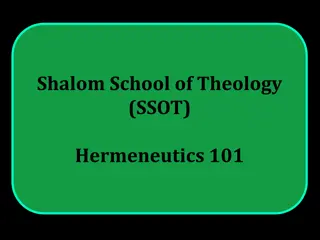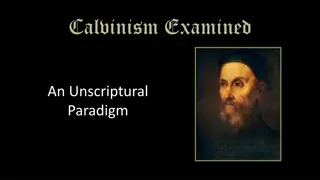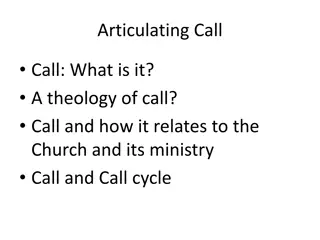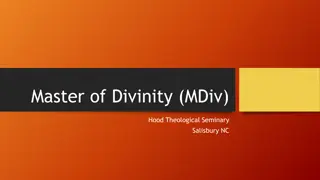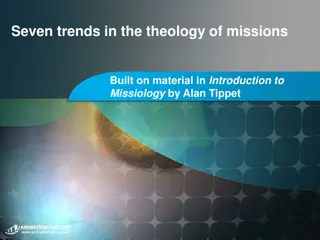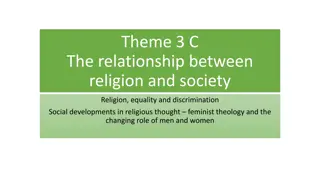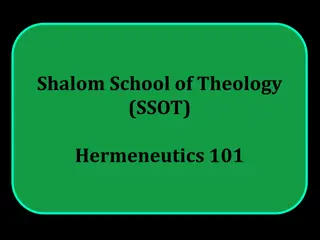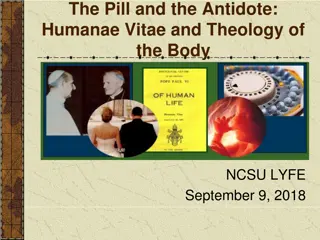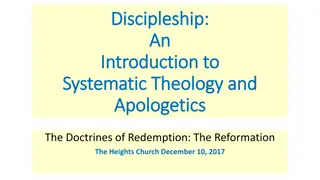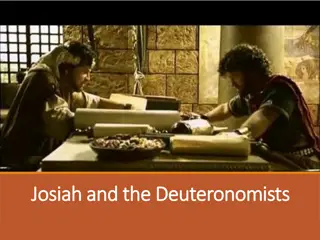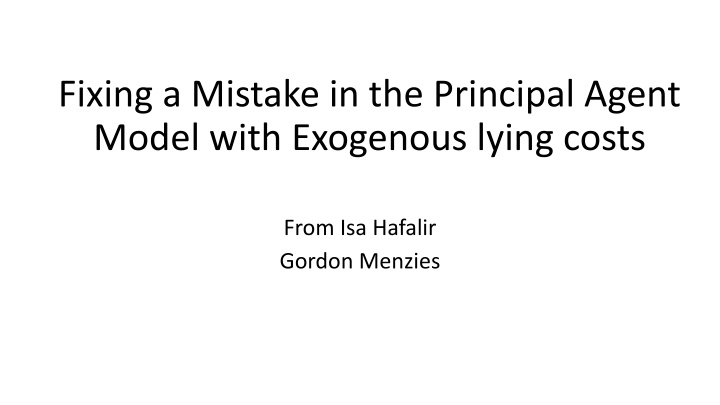
Fixing Mistakes in Principal-Agent Model with Exogenous Lying Costs
"Explore the flaws in the Principal-Agent model due to external lying costs and the implications on integrity and moral values. Analyze the shortcomings with a fresh perspective from economic Christian humanists. Discover the ethical considerations in economic theories and the role of methodological eclecticism in addressing the complexities of human behavior."
Download Presentation

Please find below an Image/Link to download the presentation.
The content on the website is provided AS IS for your information and personal use only. It may not be sold, licensed, or shared on other websites without obtaining consent from the author. If you encounter any issues during the download, it is possible that the publisher has removed the file from their server.
You are allowed to download the files provided on this website for personal or commercial use, subject to the condition that they are used lawfully. All files are the property of their respective owners.
The content on the website is provided AS IS for your information and personal use only. It may not be sold, licensed, or shared on other websites without obtaining consent from the author.
E N D
Presentation Transcript
Fixing a Mistake in the Principal Agent Model with Exogenous lying costs From Isa Hafalir Gordon Menzies
Economic (Christian) Humanists Persons are more than individuals, society is more than exchange, flourishing is more than utility maximization. Peter Eckley, Bank of England Masao Ogaki, President of the Japanese Economic Association Bernhard Kassberger, D sseldorf Institute for Competition Economics Arttu Makipaa, EU official and economist & ethicist, recent PhD on Emil Brunner
Theology and Methodogy Brunner: the closer you are to the personal the greater the noetic effects of sin Consider the progress of the social sciences vs the physical sciences A possible reason is the mystery of the human person is irreducible to one social science (including economics) Therefore methodological eclecticism is a Christian option Here we introduce a lying cost a proclivity to lie which is not model consistent. It comes from outside (another social science or theology)
This is a great failure of the curriculum of every business school I know: we teach our students the importance of cost/ benefit analysis in everything they do. In most cases, this is useful but not when it comes to behaving with. In fact, treating integrity ... as a matter of cost/benefit analysis virtually guarantees that you will not be a person of integrity. Michael Jensen, creator of Principal Agent Model In this paper we argue that Prof Jensen himself has created a model which is morally flawed in its description This is the Principal-Agent (PA) model
PA model Agent works on behalf of Principal Agents actions are hidden Output is only partly determined by Agent s hidden actions and so is not inferable from it Principal has to motivate Agent with an incentive contract Agent is risk averse (P is not) so is loaded up with risk, inefficiently The Principal has to compensate the agent for risk.
Where is the mistake in PA? Where is the mistake in PA? Principal hires Agent who expends High (H) or Low (L) hidden effort with cost to Agent y or 0. High effort makes high revenue (R) more likely (q< ) than low revenue (0). Principal pays a2 for R and b2 for 0 Technology R 0 High effort 1-q q Low effort q 1-q Reward R 0 UP = E(p)=E(Revenue-wage) a2 b2 UA= ???? ???? ?? ?????? Therefore E(UA ) = (1-q) a + q b y for high effort and q a + (1-q) b - 0 for low effort Outside option is zero
Classic Classic Principal Agent Principal Agent solution: in algebra solution: in algebra We assume R is high enough and q is low enough that Principal wants a high effort solution Solution involves meeting two conditions at minimum cost (in axb space) The participation constraint (1-q)a+qb-y 0 a (y-qb)/(1-q) H is more attractive to Agent than L (1-q)a+qb-y qa + (1-q)b a b + y/(1-2q)
Classic Principal Agent solution: Blue dot assures Classic Principal Agent solution: Blue dot assures participation participation and and high effort high effort at minimum cost at minimum cost a 4) Classic contract y/(1-2q) a = b+y/(1-2q) a=b Here is the informational rent y/(1-q) p2 a = (y q b) / (1-q) b
It is really duplicity rent It is really duplicity rent It is taken as given that any economic agent with an informational advantage who can exploit this for gain will do so But such an advantage disappears if the agent discloses the information Therefore the purported value of information relies on a willingness to lie (or decline to answer) when asked to disclose it The mistake is to assume this will always happen and not allow for agents to sometimes reliably disclose what they know i.e. to be trustworthy In contrast to current economic theory, in reality informational advantages are necessary but not sufficient for distortions and rent
If they are trustworthy, actions are effectively observable The solution is a=b=y (contingent on high effort) a 4) Classic contract y/(1-2q) a = b+y/(1-2q) a=b y/(1-q) p2 a = (y q b) / (1-q) b
The lying mechanism We change the setup Agents are paid on high or low revenue (as before) But also on declarations of high (h) or low (l) effort H and L are still important, because they still affect the probability of revenue outcomes and lying costs before R 0 Now R 0 a2 b2 a2 b2 h c2 d2 l Now if H h or L l there is a lying cost x to Agent For reasons Arttu outlined, we need not get this cost from economic analysis it could come from other social sciences or theology
If H h or L l there is a lying cost effort and declared effort (e.g.{H, l}) are actions available If effort declared effort Agent incurs x, where a low x means someone is comfortable lying, whereas a high x means they are uncomfortable. As we will see, if x=0 we have the standard case where it is pointless to seek an effort declaration x -> = rule: never lie (deontological ethics) As before H costs y but L costs 0 Now there is an additional deceit cost for agents who lie UA= ???? ???? ?? ?????? ?????? ????
Principal knows x Here are the payoffs (H, l) will not be chosen by Agent because (H, h) dominates it Rev=R Rev=0 Expected Utility Expected Profits Actions Prob, pay 1-q, a2 q, b2 (1-q) R - [(1-q)a2+q.b2] (1-q) a + q b - y {H, h} q, a2 1-q, b2 q R - [q.a2+(1-q).b2] q a + (1-q) b x {L, h} q, c2 1-q, d2 q R - [q.c2+(1-q).d2] q c + (1-q) d {L, l} 1-q, c2 q, d2 (1-q) R - [(1-q)c2+q.d2] (1-q) c + q d y -x {H, l}
Principal knows x It can be shown that in the optimal selection c=d=0 The proofs are by contradiction We suppose that in the optimal mechanism a, b, c, and d are all strictly positive We then show that exactly the same incentive structure can be achieved by setting first d and then c to zero. Rev=R Rev=0 Expected Utility Expected Profits Actions Prob, pay 1-q, a2 q, b2 (1-q) R - [(1-q)a2+q.b2] (1-q) a + q b - y {H, h} q, a2 1-q, b2 q R - [q.a2+(1-q).b2] q a + (1-q) b x {L, h} q, c2 1-q, d2 q R - [q.c2+(1-q).d2] q c + (1-q) d {L, l}
Principal knows x Rev=R Rev=0 Expected Utility Expected Profits Actions Prob, pay 1-q, a2 q, b2 (1-q) R - [(1-q)a2+q.b2] (1-q) a + q b - y {H, h} q, a2 1-q, b2 q R - [q.a2+(1-q).b2] q a + (1-q) b x {L, h} q, 0 1-q, 0 0 q R - 0 {L, l}
(L, l) is like an outside option for Agent (since its payoff is zero) Rev=R Rev=0 Expected Utility Expected Profits Actions Prob, pay 1-q, a2 q, b2 (1-q) R - [(1-q)a2+q.b2] (1-q) a + q b - y {H, h} q, a2 1-q, b2 q R - [q.a2+(1-q).b2] q a + (1-q) b x {L, h} 0 q, 0 1-q, 0 q R {L, l}
Problem: incentivize participation of (H, h) and ensure it dominates (L, h) Rev=R Rev=0 Expected Utility Expected Profits Actions Prob, pay 1-q, a2 q, b2 (1-q) R - [(1-q)a2+q.b2] (1-q) a + q b - y {H, h} q, a2 1-q, b2 q R - [q.a2+(1-q).b2] q a + (1-q) b x {L, h}
Classic Principal Agent solution: in algebra We assume R is high enough and q is low enough that Principal wants a high effort solution Then the solution involves meeting two conditions at minimum cost The participation constraint (1-q)a+qb-y 0 a (y-qb)/(1-q) H is more attractive to A than L (1-q)a+qb-y qa + (1-q)b a b + y/(1-2q)
Classic Principal Agent solution: in algebra We assume R is high enough and q is low enough that Principal wants a high effort solution Then the solution involves meeting two conditions at minimum cost The participation constraint (1-q)a+qb-y 0 a (y-qb)/(1-q) H is more attractive to A than L (H, h) is more attractive to A than (L, h) (1-q)a+qb-y qa + (1-q)b (1-q)a+qb-y qa + (1-q)b -x a b + [y-x]/(1-2q) a b + y/(1-2q)
Classic Principal Agent solution: in algebra We assume R is high enough and q is low enough that Principal wants a high effort solution Then the solution involves meeting two conditions at minimum cost The participation constraint (1-q)a+qb-y 0 a (y-qb)/(1-q) H is more attractive to A than L (H, h) is more attractive to A than (L, h) (1-q)a+qb-y qa + (1-q)b a b + y/(1-2q) OLD (1-q)a+qb-y qa + (1-q)b -x a b + [y-x]/(1-2q) NEW
We solve by adding a lying cost x > 0 We solve by adding a lying cost x > 0

